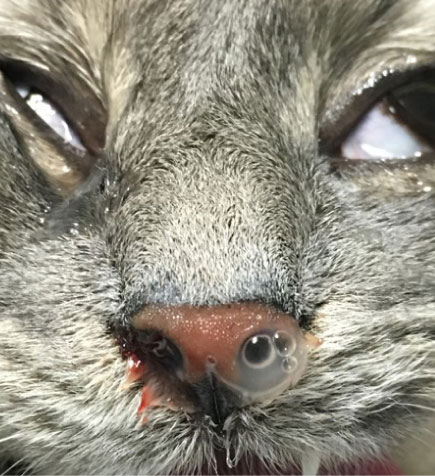cat nasal polyp sound
Where a polyp is nasopharyngeal so not in the ear but at the back of the throat above the soft palate the cat normally shows more respiratory-type signs. A cat nasal polyp is a small fleshy growth that develops on the lining of the nose.

Narrowing Of Nasal Passage In Cats Symptoms Causes Diagnosis Treatment Recovery Management Cost
A cat nasal polyp is a growth that develops on the lining of the nasal cavity or sinuses.

. The vet said the possibility of nasal polyps is possible but highly unlikely due to his age at only 5 months old. They are usually benign non-cancerous and cause no symptoms. Unusual nasal sounds whistling or snoring Difficulty breathing.
However in some cases. They are usually benign but can. The Most Common Symptoms of Nasal Polyps in Cats Incessant Sneezing or Reverse-Sneezing.
Anyone can brush off a stray sneeze by their cat right. The polyps obstruct the passage of air so affected cats usually develop a distinctive snorting sound as they breathe. You may also notice decreased airflow.
Some cats may have nasal discharge can be clear or thick yellow snotty looking Intranasal tumor is depicted most. Affected cats may have trouble breathing. Or other chemicals that may cause inflammation of the cats nasal passages until it has fully healed.
The polyps obstruct the passage of air so affected cats usually develop a. These are blobs of inflammatory tissue that protrude into the nasal passages and can get so large that they start hanging in front of the airways causing a difficult obstruction to breathe around. Well as long as it.
They are usually benign but can become cancerous. Nasopharyngeal polyps can cause signs of upper respiratory disease such as increased sounds associated with breathing sneezing and nasal discharge. These include sneezing nasal discharge sometimes reverse sneezing a startling honking sound.
Common symptoms of nasal polyps in cats may include the following. Some cats may have nasal discharge can be clear or thick yellow snotty looking. Commonly observed clinical signs include sneezing increased respiratory sounds and nasal congestion.
Symptoms of Nasal Polyps in Cats. Nasal polyps are most frequently observed in young cats. These polyps typically arise from the.
Chronic inflammation of the nasal passages either due to viral or bacterial infections can predispose a cat to develop nasal polyps. Labored and noisy breathing nasal discharge head shaking sneezing difficulty in swallowingall of these clinical signs suggest that a cat is harboring an upper respiratory problem. Nasopharygeal polyps often present as a persistent snoring sound in cats.
Commonly observed clinical signs include sneezing. Weight loss Refusal to drink or eat Swallowing difficulties Ear infection The odor from the ear Nystagmus. Secondary bacterial infections can develop due to the blockage and.
She said it could be a congenital abnormality or a mechanical.

Exclusively Cats Veterinary Hospital Blog Chronic Nasal Discharge In Cats

Nasal Nasopharyngeal Polyps In Cats Cat World

My Cat Has A Gurgling Sound In Their Throat Causes And Treatment

Nasal Polyps In Cats Vca Animal Hospital

Wired For Sound Cool Facts About Cat Ear Anatomy Fear Free Happy Homes

Feline Oronasopharyngeal Polyp Virtuavet

Why Do Cats Snort Cat Snorting Noise Meaning

Nasopharyngeal Polyps In Cats Vetgirl Veterinary Continuing Education Videos

Chronic Upper Respiratory Tract Disease Vca Animal Hospital

Cat Sinus Infection Home Remedies

Feline Rhinitis And Upper Respiratory Disease Today S Veterinary Practice

Visiting Vet Snuffles The Martha S Vineyard Times

Cat Tongue Lick Free Photo On Pixabay

Why Is My Cat Sneezing 8 Possible Reasons For Kitty Sniffles

An Interesting Case Of The Sniffles Cat Clinic

Idiopathic Chronic Rhinitis In Cats
Nasopharyngeal Polyps A Tricky Airway Problem In Cats Criticalcaredvm

What Is An Upper Respiratory Infection In Cats The Barn Cat Lady
